September/October 2011
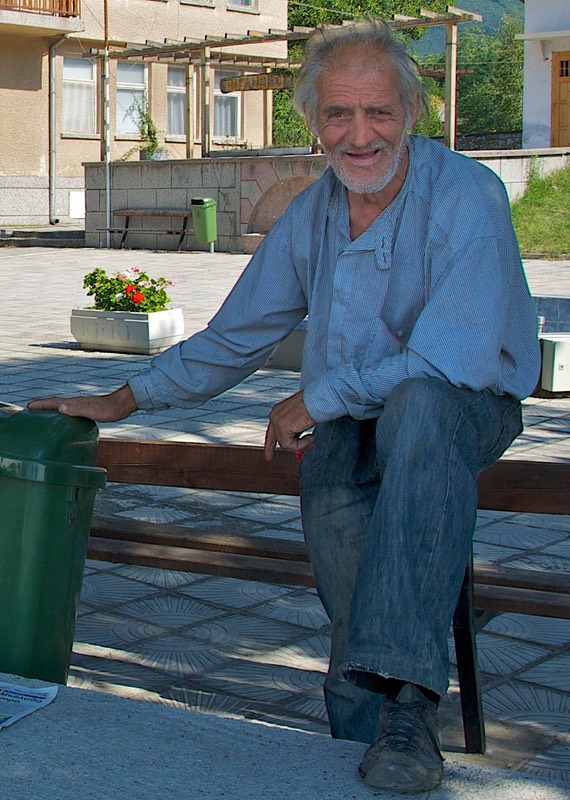
Surprising Bulgaria
Look, Mom, No Thugs
We weren’t sure what to expect as we entered Bulgaria (Bălgarija). The movies speak of the citizenry as thugs, the heavy muscle called out to do the dirty work for the Russians. Not quite as low as the Albanians maybe, but still pretty close to pond scum.
Not so, not at all! We were there for over a month all told, and found the people to be kind and friendly, full of good humor and anxious to get ahead after all those years as a Soviet satellite country. Lots of English spoken by the under-30 crowd, high fashion was de rigeur in the resort areas we visited, and, at least during August, lots of folks were off on vacation, having a great time. As did we. We saw a lot of the mountainous areas, and the Danube Plain, along with ducking in and out of Sofia. The only area we really missed was the Black Sea coast; we hope to visit there next year.
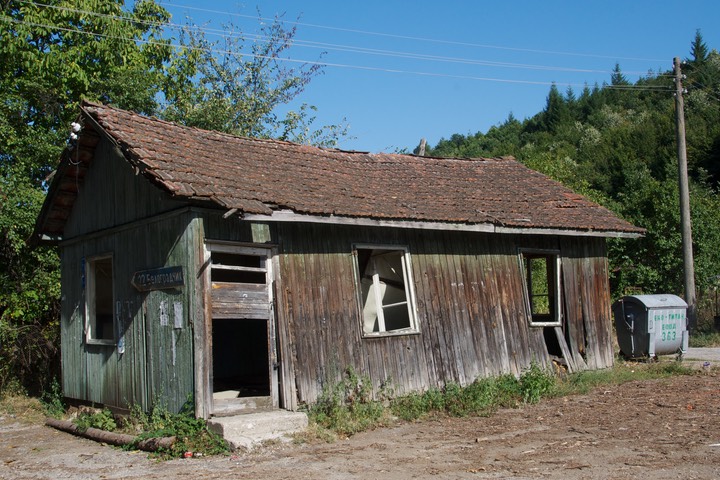
As we crossed the border from Serbia, in the northwestern mountains, immediately we noticed differences. The towns seemed old and poor; many appeared semi-abandoned. The inhabitants were old; perhaps the younger generation had left for more profitable, more modern areas. It was late summer and very hot and dry. There were lots of trees in the villages, but they were very dusty looking and seemed almost to be dying. Sunflowers were being grown as a crop, and they were finished for the year; no longer beautiful yellow, they were dry, dry brown. We began seeing donkeys in the fields, and more horse-drawn carts. This was true not only in the small towns but in the cities as well. I was able to take a great picture of a horse and cart waiting in the left turn lane for the light to change so they could cross the traffic – in downtown Sofia, the capital. Bulgaria is a member of the European Union, perhaps its poorest member; it lags significantly behind countries further west.
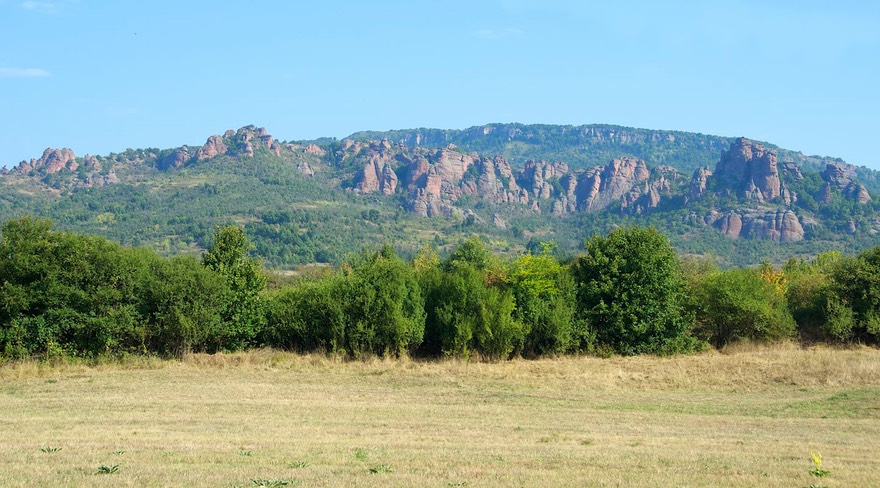
There were other differences in this new country as well. Cyrillic was even more common; it was rare to see a town name that we could recognize from the letters. The words on the buildings meant even less than before and more of the buildings just had the look that spells out ‘Soviet Era’ to our western eyes. This was what we expected from a former Soviet state.
In August, at the lower altitudes Bulgaria is overwhelmingly hot. Our game plan for visiting the country was to stay in the mountains as much as possible. We like mountains anyway, so this was an easy choice. Our first stop, close to the border, was in Belogradchik, to visit its famous rock formations (Belogradčiški Skali), which were kind of like those we’ve seen before in Utah or northwest Argentina. It was our first “city” – old buildings and soviet-era statues; but clean and tidy. There were more trashcans and recycling barrels than we’d seen in many a moon (maybe EU provided?). But someone said no provision had been made for processing the recycled materials. Maybe later.
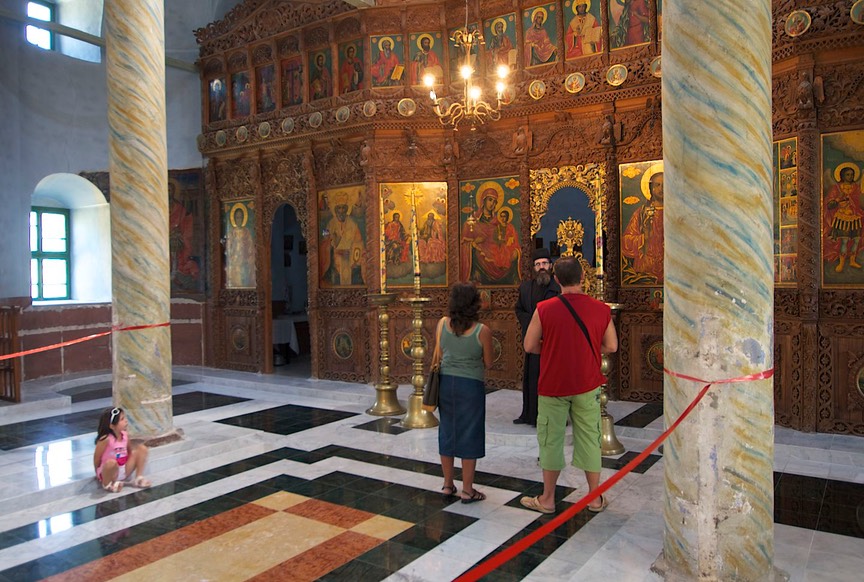
Bulgaria is famous for its really splendid monasteries. With a few exceptions, they are found in country settings, among trees (often pines), simple in design but elaborate in decoration. The iconostasis in each church seems to be in a contest with every other iconostasis: they are bigger than in other countries and more covered with carvings, and rather than just one, often there also are little ones in the nooks and crannies of the church. So what’s an iconostasis? It’s a wooden screen; there’s one behind each altar, and each one is covered with gold painted icons (pictures of saints). They were the artistic focus of an entire school of woodcarvers who were amazingly accomplished. They are delightful to investigate.
Lopushanski Manistir in Georgi-Damyanovo was the first we saw. South of Beogradchik and off in the middle of nowhere, set among a stand of pines, it set a high standard for what we would see here. We were alone in our visit, except for a small Bulgarian family, and the monk spent a lot of time with them so we got to listen to the unfamiliar words; they added a lot to the experience. A monastery compound typically consists of an enclosure (usually with a very low lintel that you have to duck under in order to gain entry). There will be a church, an open area under the trees, and cells where the monks live. Sometimes you can stay there for a night, and often the cells are open for your investigation. In Bulgaria the religion is what we call eastern orthodox; many were destroyed during the days of the Ottoman empire and have been rebuilt since.
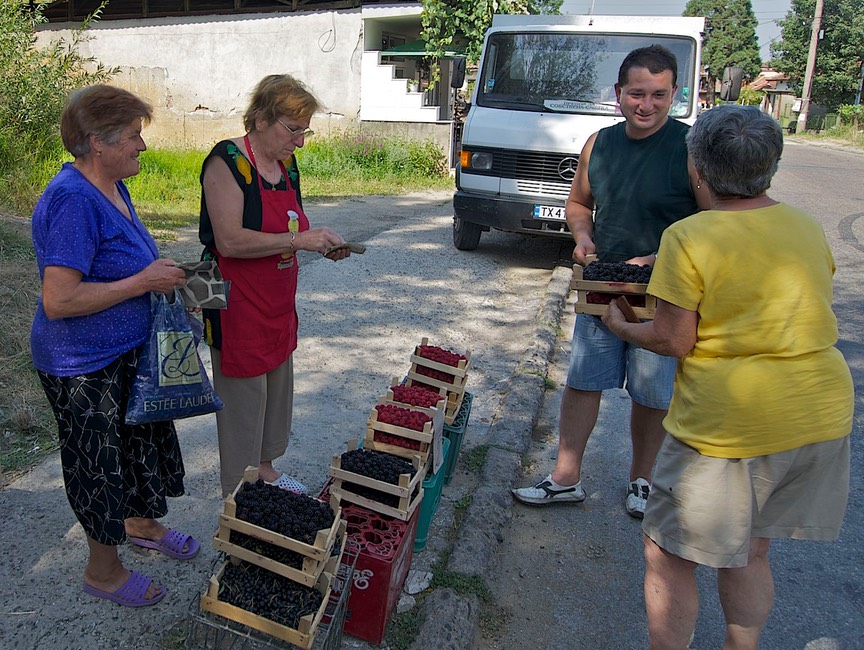
Later that afternoon, we bought blackberries and raspberries from three ladies beside the road that wove through their mountain hamlet; there were perhaps a dozen other women, all sitting in a row. Hopefully they shared around the money earned this way, as who could choose which group to give your money to? The berries were sitting in homemade wooden boxes made of crudely cut slats. I tried to offer the boxes back, not needing them and thinking they could be reused, but couldn’t make myself understood. No surprise.
We climbed further up the “berry ladies” road to Petrohanski Pass, where we stayed a couple of days, getting organized for this new adventure, then dropped south from the pass and took a side road over to Svoge to pick up the road up through the locally famous Ishkar Gorge. We were still seeing a lot of water coming off the mountains, with regular springs beside the roads. As gorges go, the Ishkar was okay; we’ve found they don’t do much for us, but this at least had plenty of pull-offs to enjoy the view.
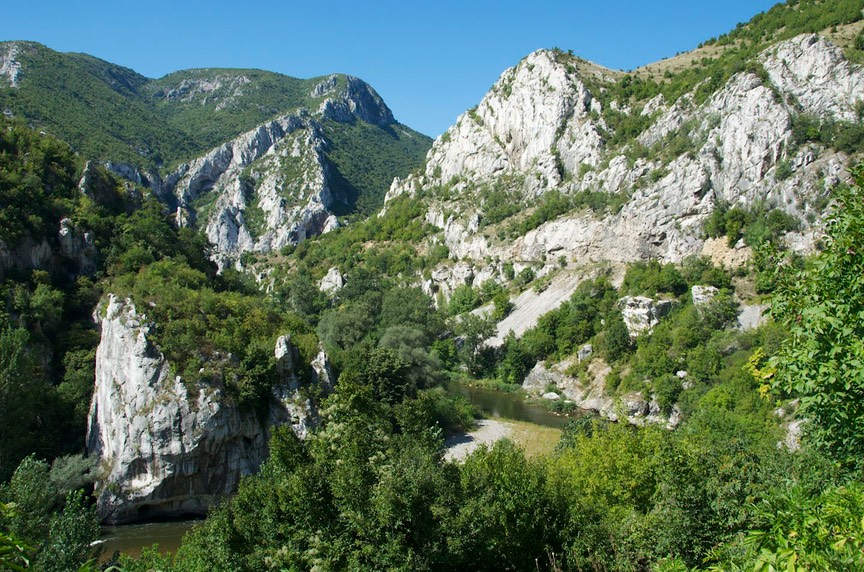
Cherepish Monastery is at one end of the gorge, in a lovely setting on the river, and was a real favorite. In addition to all the above-described delights, one of the monks was chanting while we were there; such a beautiful voice. Later, he spoke with us while enjoying a cigarette, which was a bit startling. Among other things, he explained that there are two classifications for the monks, either marry-able or celibate. Even later on in the afternoon I saw him wandering around in a pair of jeans and black tee-shirt.
Moving toward Sofia, we stopped and visited Vraca (Vratsa). We parked for the night out of town on a bluff overlooking the river that flows through town. In the morning a fox, out hunting, spent some time in the area, presumably looking for mice. Vraca is a nice town. I wanted to mail a letter, and at the post office I had to get help from various people. I was able to pay for stamps, but she wouldn’t take the letter from me, pointing outside and around the corner. Such a puzzle. Eventually someone helped me figure out that there were several slots in the wall of the building, and we decided that if we put my letter in one, it might even get out of town. Very strange. Another time, in a different town, I went through the same process, but the clerk was happy to take my letter from me and send it on its way.
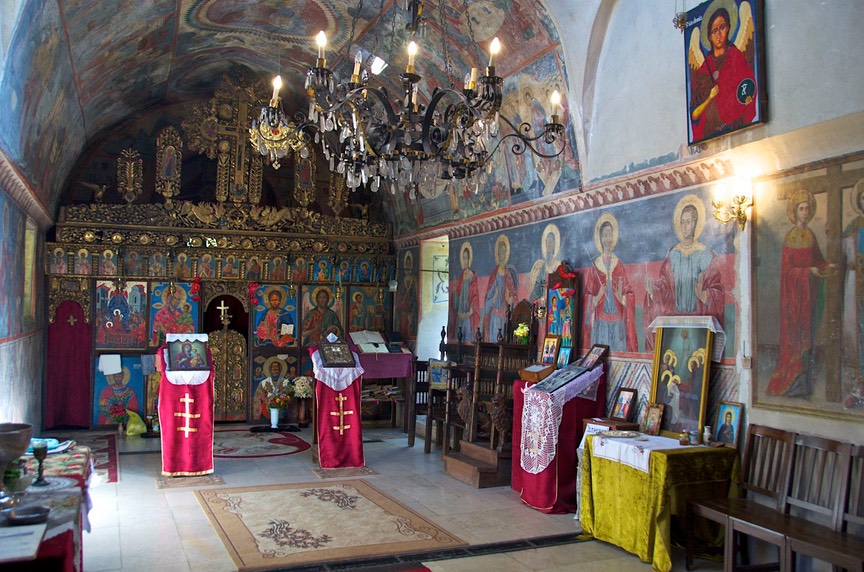
Internet proved a little difficult in Bulgaria. We found that hotels often were our best source. For the price of a cup of coffee, we would be welcome to sit in the lobby for as long as we wished. In Vraca there was a wedding going on at the hotel, and we were entertained by a great band while we caught up with the outside world. Vraca had all the appearances of an old-fashioned resort town. There were lots of little kids being taken care of by their grandparents. It was the last week of August.
Just before leaving town we stopped at the Kaufland supermarket, where we found cheddar cheese (!), and also encountered Peter and Miriam from Dorset, England who had just bought a house here. We chatted, and hope to visit them at some point. They are teachers who plan to retire here. Several times while we were in Bulgaria we ran into Brits who were settling in this country. There are several reasons, most of them economic. Bulgaria is a very poor country, and lacks many things, but it is definitely less expensive than the rest of the European Union. It’s forward-looking, and slowly becoming more modern. We think the influx of immigrants from more western areas probably is good, although (no surprise) we like the areas best that haven’t changed.
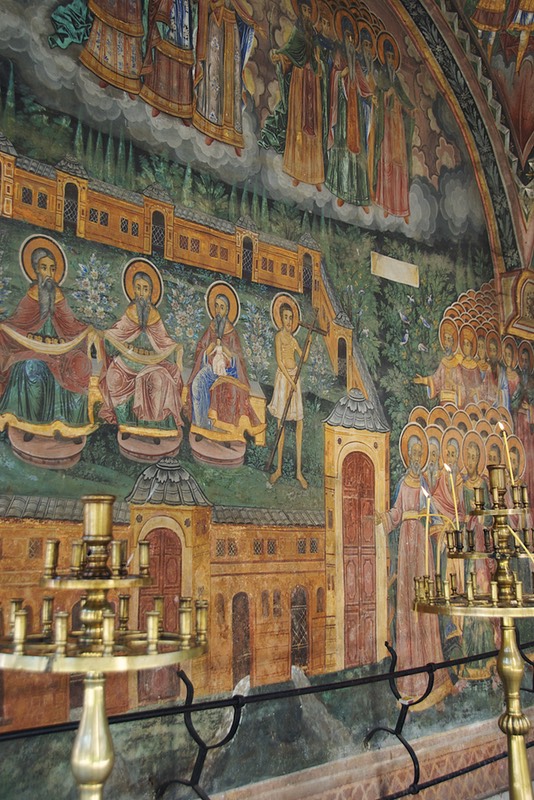
Finally tearing ourselves away from Vraca, we followed the pretty Beli Vit river valley through the mountains to the Troyan Monastery. Very big, very famous, very much a place of pilgrimage, it was also touristy, with plenty of souvenir stands at hand. But the grounds and church inside were quite lovely, and it was interesting watching a baby being blessed, complete with lots of candles and much chanting over his head. This was a very popular activity; we saw lots of babies on our monastery visits.
We moved on through the mountains; regularly we saw packhorses loaded down with logs. Providing firewood is an ongoing, year round occupation in Bulgaria and pack animals are used a lot. The wood was being taken to a central place, and had already been cut to firewood size. These looked like subsistence operations, for local families, not a big business trucking wood long distances. We also saw beehives everywhere, sitting among the dying sunflowers, and honey was available regularly. We’ve bought some; it’s quite sublime.
Our goal now was Veliko Tarnovo and a campground nearby where we were expecting a shipment from the States to arrive in a week or two. We wanted to check in, spend a few days relaxing, and then visit more of the area while we waited. Veliko Tarnovo is a famous old medieval city with castle, etc. It’s a great spot. We never got the chance to really visit, mostly going in and out making arrangements for our shipments to clear customs. Being down on the Danube Plain, it also was very, very hot; when we were leaving the final time, we intended to do some more sightseeing, but it was 95 degrees and we just couldn’t manage to get interested. Another year.
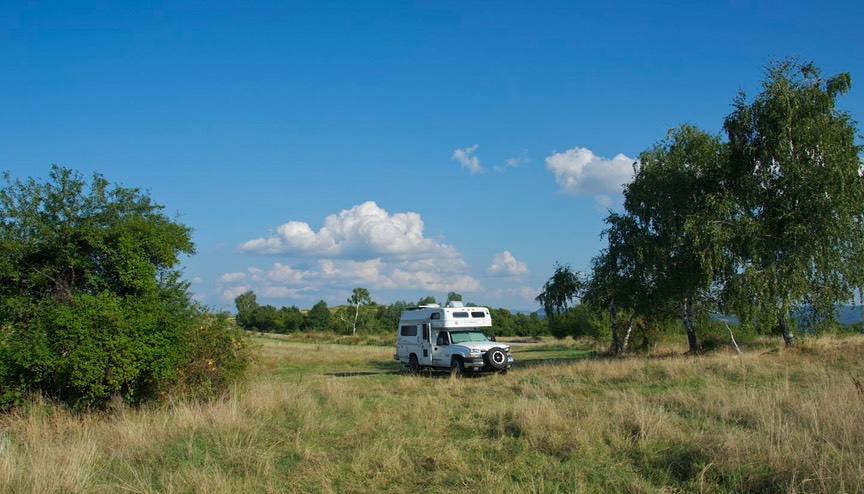
This business of shipping things from the US into foreign countries is not for the faint of heart. We won’t bore you with all the details; suffice it to say that it involved several trips to and from Veliko Tarnovo, a fair amount of money changing hands, a local translator, notarized documents and most of all, a ton of help from a delightful UPS woman in Sofia. We would have been in great difficulty without all the help she gave us. If you ever find yourself needing to ship something to Bulgaria, make absolutely certain it goes via UPS and ask for Loret.
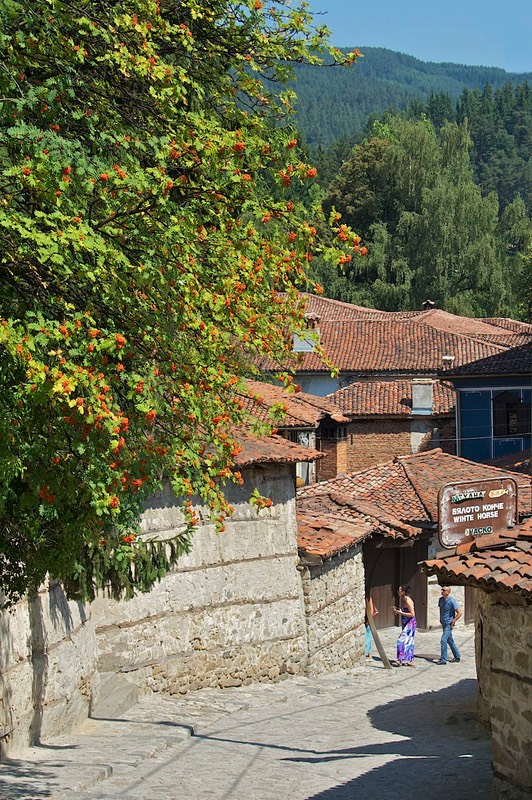
While we waited for stuff, we wandered the area south and east of the city, but staying up in the mountains. This is very interesting countryside. In the Tryavna area we parked on the edge of a field in rolling hills; first the cows and their cowherd came by, and then the sheep and shepherd. It was delightful and quiet.
We visited both Koprivshtitsa, full of old half-timbered houses with their second stories hanging over the streets, and Tryavna, also charming and picturesque. These are traditional villages that have been maintained as such. They were low key and very interesting. 1 kilo ripe peaches – 1 lev ($.70); jam 2 levs ($1.40). Wonderful watermelons everywhere, and more autumn colors.
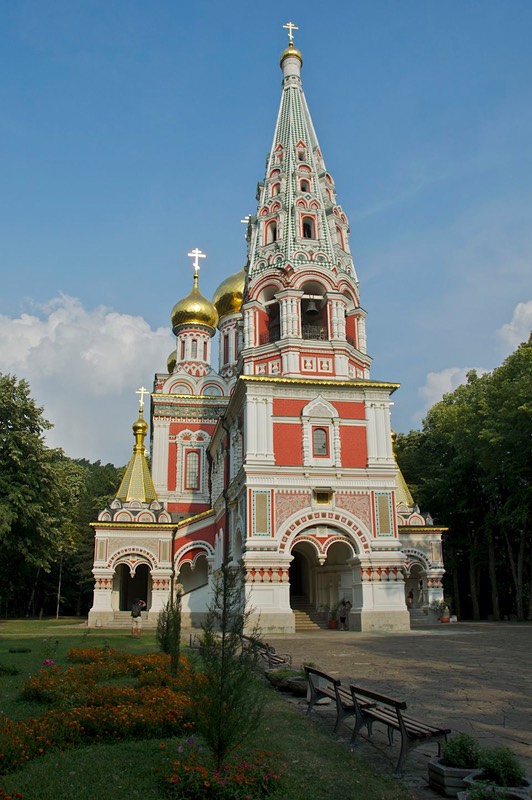
During this waiting period, we traveled back and forth over the various mountain passes that traverse the area between northern and southern Bulgaria. It’s all quite nice. Crossing the Shipka pass, we stopped to see the monuments at the top. There are monuments all over Bulgaria; their obvious Soviet origin and style seem somewhat ridiculous to us but the locals really eat it up. Before going over the pass, we spent the night in Shipka, at the Memorial church there. It’s quite an edifice. It was designed to look like a 17th century Russian church and it really stands out. Also, it has a wonderful, enormous bell; it rang for us several times during the night and it was terrific. Incidentally, the Shipka pass is where the Russians and Bulgarians defeated the Ottoman Turks and liberated the Bulgarians from 500 years of Turkish rule in 1878. Of much less interest to the locals, but seemingly more significant to us, it’s where Alexander the Great battled the Thracians in 335 BC.
We poked around a bit in the Valley of the Roses area, badly misnamed. There is a very large rose-production industry, but it’s off the main roads, and not really a tourist area. But the main highway between Sofia and the Black Sea passes through there, and it has become an area of rural ranching: nice city cars, bad roads. There are lots of weekend homes, but the farming is still very traditional, and most of the little towns look quite forlorn. As always, we like the little stuff: farmers hand-scything the hay, carts with kids in charge ambling down the road, a tractor moving a load from here to there. Gentle things.
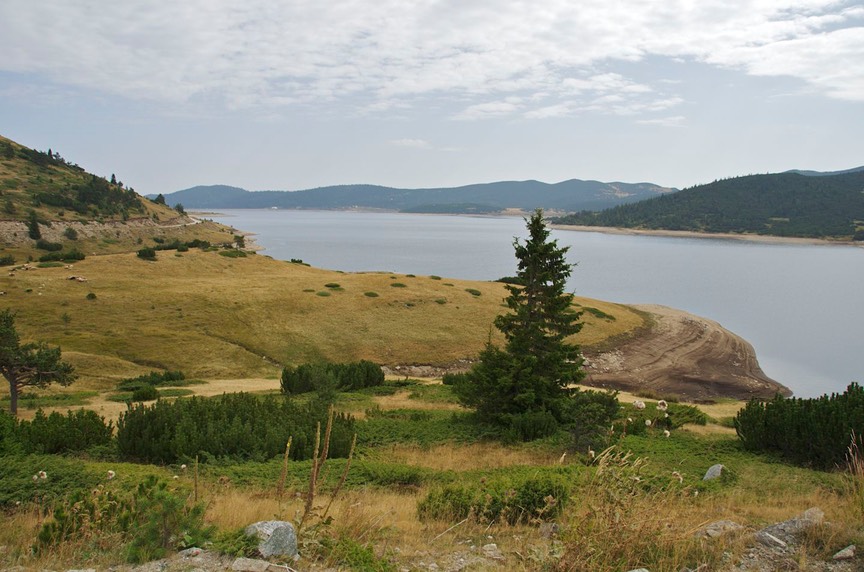
We went through Karlova, the birthplace of Vasil Levski. A hero of the revolution. We were reminded that Bulgaria has a whole different set of heroes than we are used to. It’s a very different culture.
South of Sofia are the Rila Mountains. We wanted to check the area out, although we knew the roads were pretty bad; unfortunately, Bulgaria is infamous for its roads. We spent one night in Sestimo, parked along a deserted former industrial zone that was filled with enormous concrete jacks (probably for building bridges). We thought about Gulliver. We passed through the crazy village of Belovo, which produces toilet paper. There are stacks of it for sale beside the road; apparently the factory likes to give the employees product instead of money from time to time; how’s that for ‘stock’ options? Probably time for one of our, “No, we’re not making this up” disclaimers.
We took a winding tiny road through the Rilas, past Jazovir Belmeken, a reservoir that looks to be very popular during the summer, although very quiet now that it’s well into September. There were a couple of motorhomes parked beside the water, but no facilities. Bought local honey made from thistles, being sold by a young woman who spoke very good English. I asked her about peach jam; I cannot find it at roadside stands, although peaches are available everywhere right now. She looked puzzled and said her mother made peach jam; it was like why should I need to buy it, because everyone makes their own.
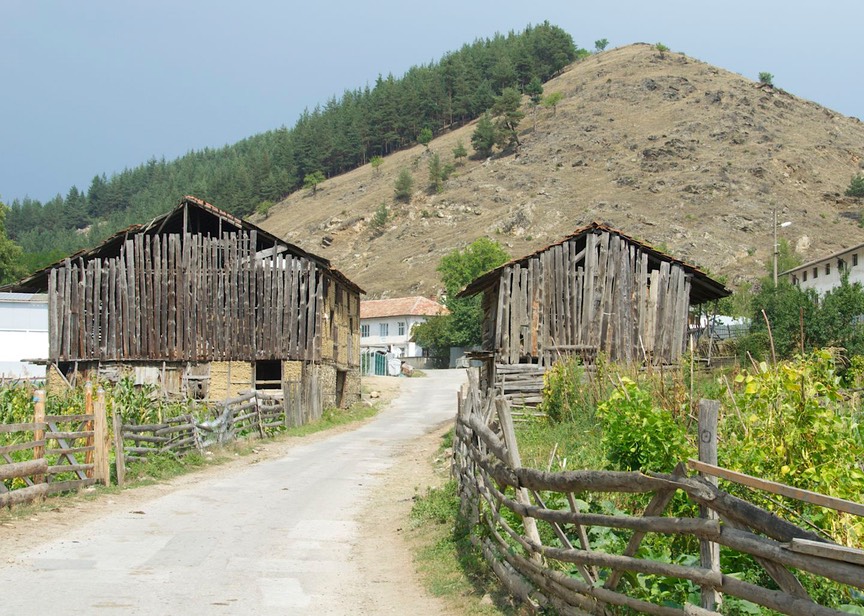
The Bulgarian ski team was out practicing on the long downslopes in these mountains. It was fun to watch. As we got back to a lower elevation there was tobacco drying on racks in the fields. Everywhere we went there were animals with carts and stuff for sale beside the roads. Bulgaria is poor, and in places people are struggling.
As a last adventure in the Rila Mountains, we wanted to go and visit the Dancing Bears rescue facility. As you might expect, bears are rescued from situations where they are being used in terrible ways and badly mistreated, including in circuses. The location was up this really, really bad road. It got worse and worse. Pavement turned to gravel then to mud. It was now raining. We got to where it was supposed to be and there was a sign saying 2.5 km further. It was late and we finally decided to give up, so we didn’t get to see the bears. But it was a great location, out in the middle of a grassy woods, absolutely nowhere. The bears have an open environment, but they have been in captivity so long they cannot exist on their own. Bummer. Would have liked to have seen them.
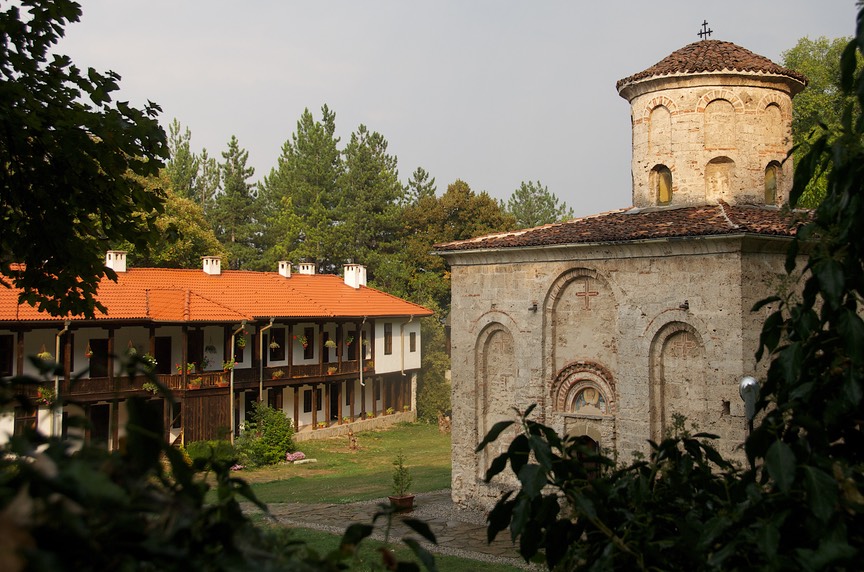
But for us, it was time to go back to Veliko Tarnovo and our UPS/FedEx adventures, finally even receiving our stuff. It was still terribly hot but we needed to get some repairs done, so we stayed for a few days panting away as we worked. As we left, we stopped briefly in Veliko Tarnovo to see what we were missing, and also to check out a bookstore that had a good supply of English used paperbacks. It was a treasure trove, and we scored big. Well worth the visit, as we were running low.
During a chat with the owner, she talked about changes in the town in the last few years, with more people arriving. Many had bought in just before 2007, when Bulgaria joined the EU, perhaps anticipating an upswing in prices. Some were now selling, for various reasons, and finding their property worth less than they’d purchased it for. The world economy is bad everywhere.
By now it was mid-September, and we wanted ocean!!! We beat feet for the Troyan Pass and Sofia. The Troyan is our favorite pass in Bulgaria, despite the absurd enormous monument at the top celebrating various Bulgarian victories.
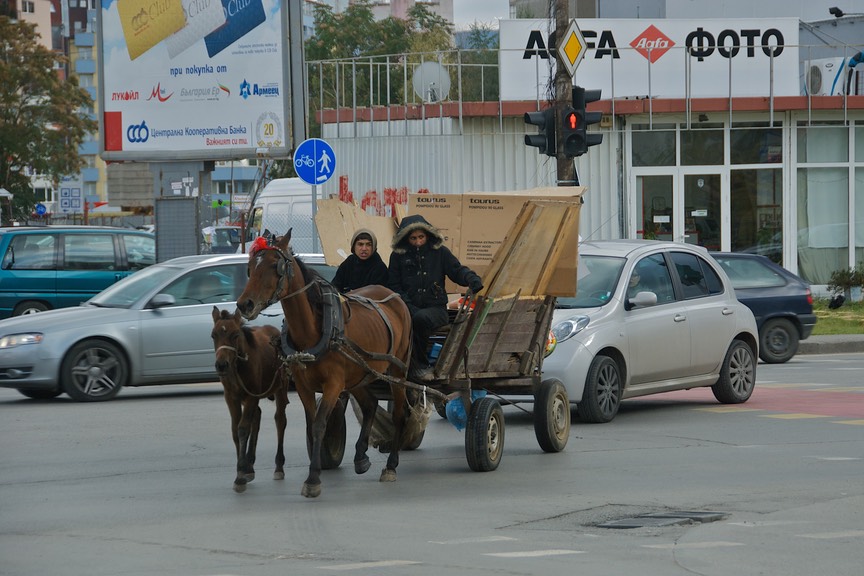
Heading out of the country, we made a last stop at the Zemen monastery, in a lovely, hilly neighborhood in the Sofia suburbs. Small but exquisite, the setting for the complex was the best part of all. As with others we stopped at, it was isolated and among trees; what better spot for a retreat.
The next morning we briefly dipped into Sofia, but it was a bit of a downer. We wanted to visit the old center; there were well-known museums and churches we were anxious to see, but Sofia is a very big city. We went through poor areas with shacks and ill-dressed children; we’d been able to avoid most of this up until now. The road was so bad that Rick commented that he had never seen washboarded asphalt before. Sofia’s center is old-fashioned, with ancient trams that look like they’re left over from the 1930s, and cobblestoned streets, and not nearly enough parking for the onslaught of cars that have arrived in Bulgaria since independence. We might have been okay, but it was Sunday, and there was a huge street fair going on. What parking did exist was either taken up with tents, or long since filled. We saw some interesting sights but could never stop to take pictures, so we went on. Maybe there’ll be another chance.
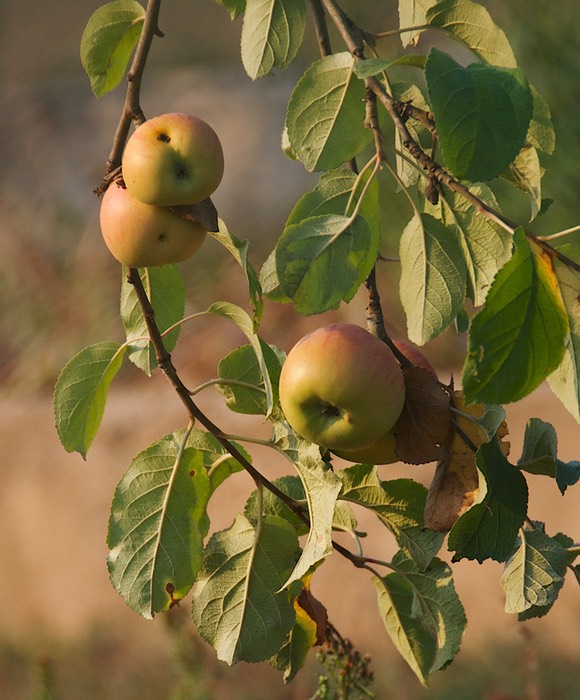
We spent one last night close to the border (we generally avoid changing countries late in the afternoon). Leaving the main road, we went up into the hills aways, and thought we had gotten off into an area where there was NOBODY. Silly us. A little yellow bus went by, not once but several times, as it connected with the villages nearby. And then, not once but twice, we had police (probably border patrol) stop to chat. They weren’t trying to move us along, but did check our papers and passports and ask us where we were headed.
The next morning we crossed into Serbia and then Bosnia and (finally) the Croatian coast. Good adventures there, which you’ve already heard about. Mid-October we crossed into Montenegro, tiptoed across Serbia so we could avoid Kosovo, and back into Bulgaria again. (We had fully intended to spend a couple of days in Kosovo, but when we found out that vehicle insurance would be 30€ at the border, we decided to skip it.)
At this point our aim was to pick up mail in southeastern Bulgaria and head right on into Turkey. We entered Bulgaria back up near Sofia again (getting to be a habit, it seemed) and, after a short visit to the Bačkovo monastery, south of the capital, took a pretty straight path southeast, past Plovdiv to Biser, the campground where our packet awaited us.
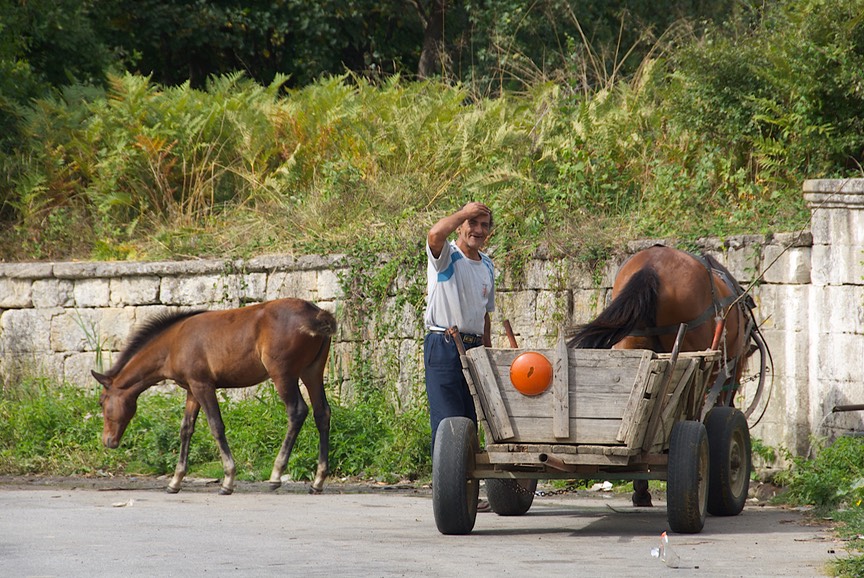
We were happy to be back. We like a lot of things about Bulgaria. It’s a step back in time and just a little bit exotic. We’d never visited a former Soviet satellite country before. The silly old statues are a hoot, the Cyrillic lettering is quite impossible but also quite nifty, and the countryside is very pleasant. There are lots of mountains to enjoy, and although we no longer needed them for cooler breezes, they were very pleasant to pass through.
However, we were anxious to get our packages and go on. By now we had, very reluctantly, decided that Turkey would have to wait until next year. While in Montenegro, Rick had discovered that we had a badly cracked wheel. It was unusable, and even though we thought we were okay in the short term, we decided that being up a creek without a paddle in Turkey was not the best of choices. We figured we could turn west instead of east, go across Macedonia and Albania, down into Greece, take a ferry across to Italy, and slowly move up towards England. We would have new wheels shipped to us there; also, there were other things that needed doing to the coach, and that would be the place where it would all happen. More on all this later.
We enjoyed several days of balmy, late autumn weather at the campground in Biser. It was run by Brits, and we met several other English folks while we were there. One family had just bought a house nearby, and were waiting for spring to begin renovations; they had rented an apartment over the office and would hang out there over the winter. Matt, the fellow running the campground, knew a good mechanic in town so we got some basic service work done on the truck, thus adding Bulgaria to the list of out-of-the-way countries where we’ve been able to find competent guys to take care of La Tortuga for us. Some of the others are Costa Rica, Colombia, Peru, Chile, Scotland and Morocco.
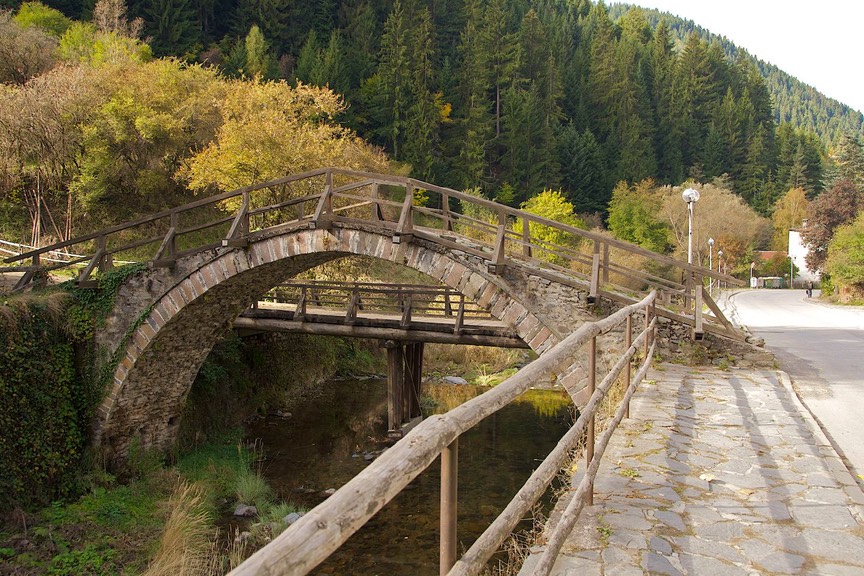
Southeastern Bulgaria is home to many old Soviet-era industrial cities and power plants; much of the area is quite flat. Not all that interesting. But… we suddenly came across a Burger King out in the middle of nowhere and screeched to a halt. Even better than when we found the In ’N Out Burger in Croatia. My, my, my! And they had great wifi. We hung around a long time, spending the night in their parking lot (very quiet and peaceful) while Rick researched replacement wheels.
Macedonia was calling us, so on we finally went. Moving west across southern Bulgaria, we had a very nice time. We traveled up the pretty Chapelarska Gorge and through the western Rhodopes Mountains; Rick insists on calling these the ‘Rope-a-Dopes’.
High enough to have snow on the ground, and due south of Sofia (but a long ways south) we went through a very nice resort area. There were a fair number of people around, enjoying the bracing air and probably chomping at the bit for more snow to fall. But we kept moving, knowing that snow was not what we wanted to be seeing!
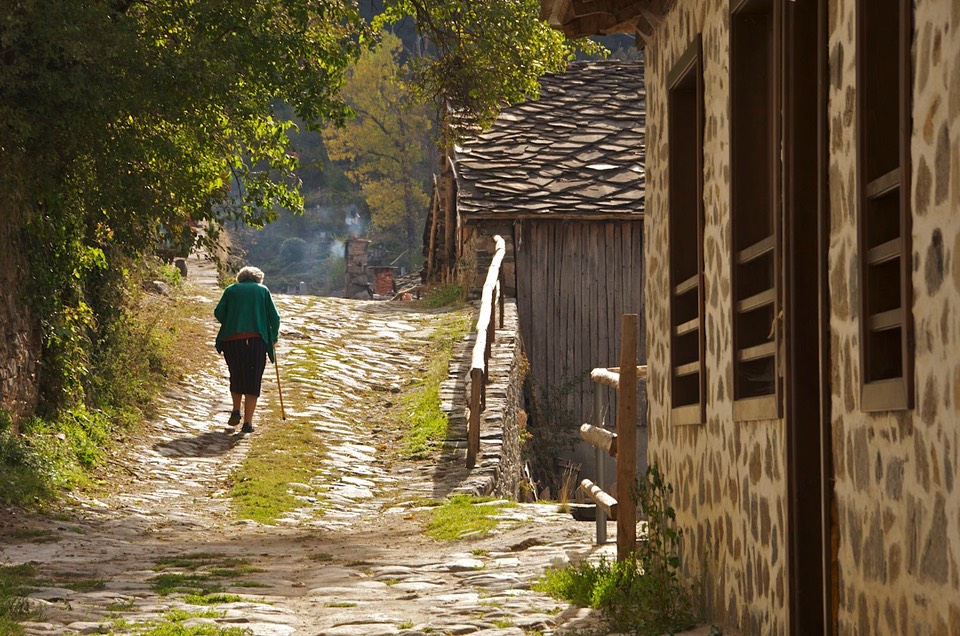
Further west, we went through an area of very traditional old villages with slate roofs and interestingly patterned buildings, with small stones set into the walls on the lower levels of the houses. Oh, and neat humpbacked bridges. We spent a couple of nice hours wandering around Shiroka Laka, really enjoying the town. Roof repairs were underway on many of the homes, and piles of slate were everywhere, fighting for space with stacks of firewood. This was part of a Pomak region, home of Slavic muslims. We poked around the small church; there was a very nice example of the decorative work they call naïve art. This simply means it was done in a simple manner by local artists. Similar to Grandma Moses, if you are familiar with her work. We were in Shiroka Laka mid-morning, and many members of the community were out enjoying the morning sunshine and going about their usual business, much of which involved stopping to chat or have coffee at tables alongside the road. For whatever reason, the area is big on bagpipes, and there’s a big festival, in August I believe. Maybe we need to come back again.
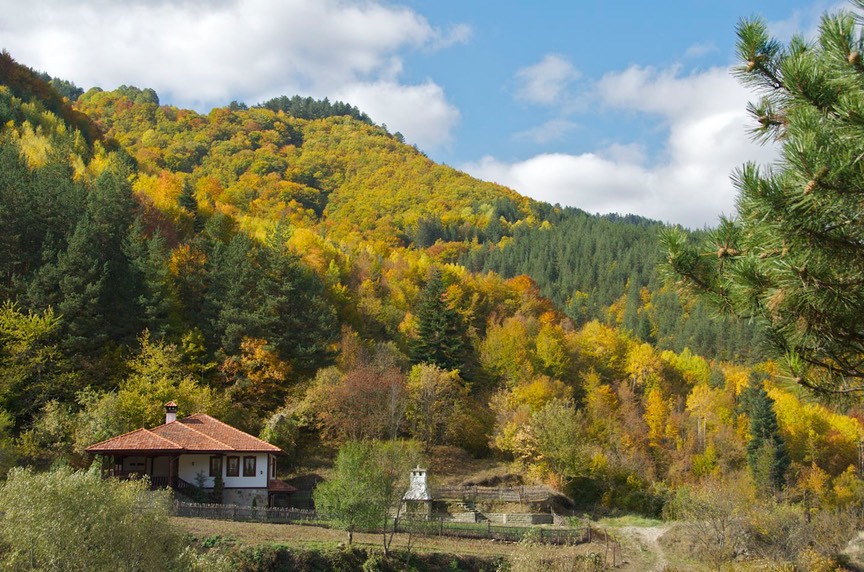
The forests in this area were really lovely and dark, making a wonderful contrast with the increasing colors of fall; it was a gorgeous drive. The trees reminded us that we were getting close to Macedonia, famous for its black forests. As we drove along, in addition to the usual logs beside the road, there were frequent piles of quarried stone, much of it slate. Some of it was being worked on by hand, by people sitting beside the road, splitting the rock with hammer and chisel. We spent that night on a bluff overlooking the town of Gotse Delchev, with the Mesta River running through it. The next day it was much warmer, sunnier, and we were happier. Amazing fall color was everywhere.
Western Bulgaria is lovely from north to south, mostly mountains with pretty valleys between. Close to the border the hills are drier and more arid. The valleys are full of vineyards; at this time of year they were through with harvest and the vines were very dry and brown.
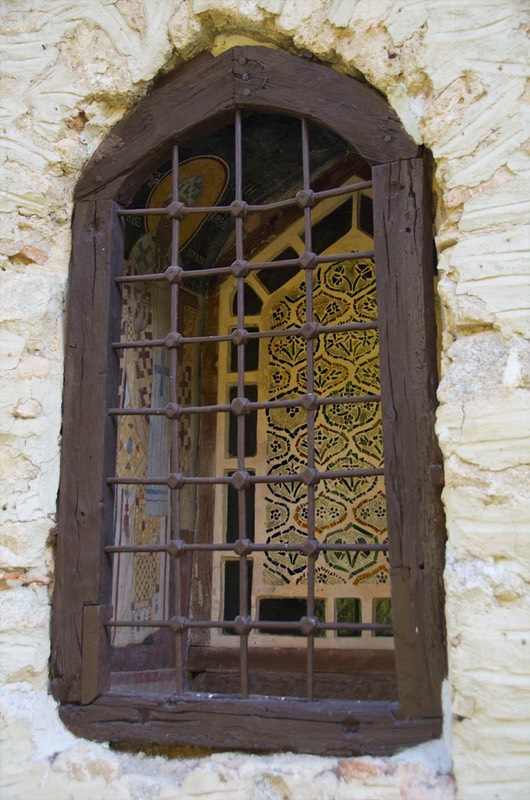
We had one last monastery in mind, and it turned out to be a perfect ending to our time in Bulgaria. Outside the town of Melnik, up a winding road through some weird sand dune kind of formations, we came to the village of Rozhen and the Roženski Monastery. It was in a pretty, open setting on a knoll; rural and quiet and secluded. We ducked under the lintel at the entrance (they sure grew them smaller back in medieval times) and wandered for an hour or so. The frescoes were really good; although, as with almost all the old churches, they had been defaced, included many of the saints having their eyes scratched right off the walls. It was a charming and unpretentious site, and immediately became one of our favorites.
The next day we crossed the border into Macedonia, leaving the European Union behind yet again, changing money yet again, and hoping we could stay warm enough in these cold and mountainous areas to keep ahead of winter.
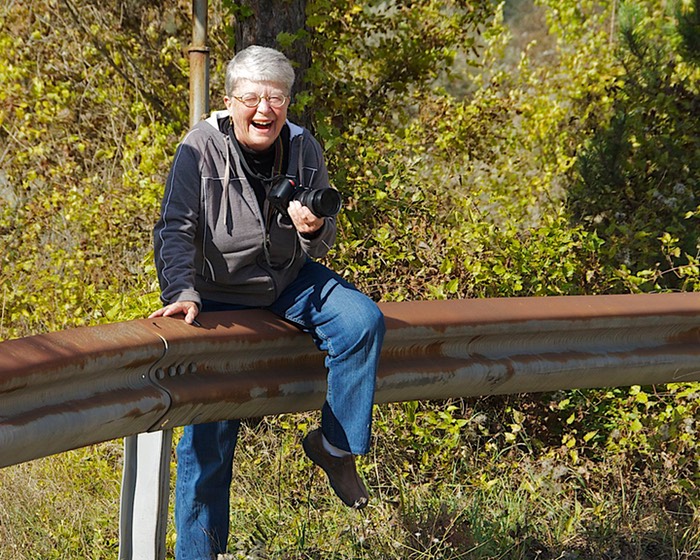
All told, we’d spent 37 nights in Bulgaria, and it had been a very good adventure. The roads left something to be desired (some were pretty bad), the country seemed to be looking for a kick-start to bring it into the 21st century, and some areas were quite sad. It’s a country with a history totally different from “mainstream” Europe, and we liked that. And, you know, we never did run into any thugs, quite the contrary.
The Bulgarians we talked to were delighted to see us, if puzzled as to why we would want to visit. “You came to Bulgaria?” was said to us with amazement and perhaps just a little pride. Yes, and we’re glad we did.
So long for the moment, but we’ll be back at you shortly with the rest of The Story of the Wheels.
Rick and Kathy and Lady Tortuga, suffering from a bit of gout at the moment.
Click to see more photos from Bulgaria